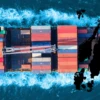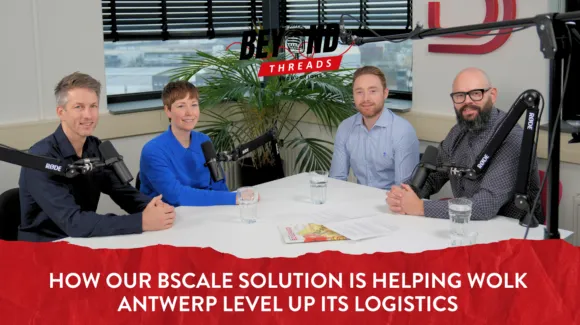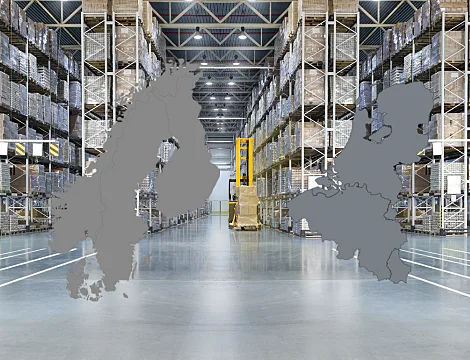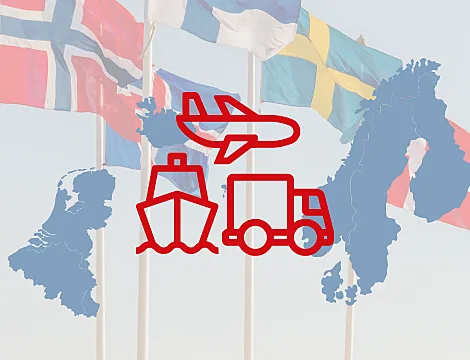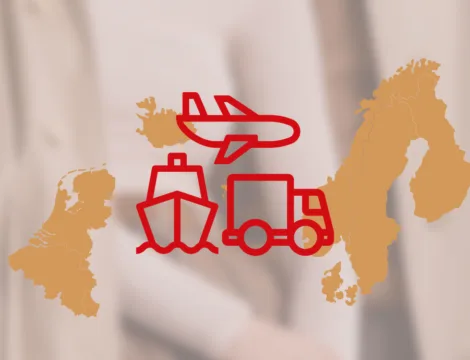Moving your logistics operations from the Nordics to the Benelux region requires careful planning. You need to understand the nuances of the Benelux market and its logistics infrastructure. In this blog, we’re offering Nordic brands five key tips as they prepare to move their fulfilment operations south.
In a world where efficiency and seamless customer service are essential, the role of strategic logistics management is more important than ever. With easy access to several lucrative European markets, the Benelux region is an obvious choice for optimising logistics operations. Several Nordic fashion companies have already made the move.
For more on why these companies have taken the plunge, make sure you read our article ‘Why is the Benelux region a logistics hotspot for Nordic fashion brands?’. But for those who have already decided that moving south is the best thing for their business, here are five important steps to take:
1. Optimise supply chain routes
2. Establish trusted local partnerships
3. Prioritise sustainability
4. Understand local regulations and compliance
5. Stay informed about market dynamics
1. Optimise supply chain routes
The Benelux is an ideal geographical hub for optimising supply chain routes. It is home to Europe’s two largest seaports, Rotterdam and Antwerp, and also offers multimodal transport solutions. These ports are strategic entry points for goods destined for various European markets. If you are considering setting up your logistics operations in the Benelux, determine the most efficient entry and exit points for your goods based on your target markets and distribution networks. Consider factors such as proximity to the target market, available facilities, cost efficiency and the ease with which goods can be transferred to subsequent modes of transport.
The Benelux region has a complex landscape of transport networks. These offer companies multimodal transport solutions – combining sea, rail and road – to optimise the movement of goods from the port of entry to the final destination. Be sure to explore the different options as they can save money, increase efficiency and ensure the reliable delivery of goods. The use of intermodal containers also reduces handling costs and increases the security of goods by reducing the need for repackaging when transferring between different modes.
2. Establish trusted local partnerships
Moving your logistics operations to a new region can bring uncertainties. That’s why it’s important to form strategic alliances with local logistics providers who understand the nuances of the regional landscape. Their knowledge, experience and capabilities will open the door to best practices, optimal routes and potential pitfalls. These pitfalls relate not only to the physical movement of goods but also to navigating regulatory compliance, customer expectations and market trends that are unique to the region. Local partners can also help you to find hidden shortcuts, untapped opportunities and efficient alternatives that might otherwise be difficult for an outsider to identify.
3. Prioritise sustainability
Like Nordics, the Benelux countries have embraced the transition to greener logistics. It’s important to take advantage of this synergy when setting up operations in the Benelux. Companies shouldn’t just see sustainability as a compliance requirement, but as a shared vision that is an important part of the fabric of logistics operations in these regions.
With increasing environmental concerns, reducing the footprint of your operations is a top priority. This includes using fuel-efficient vehicles or opting for rail transport. But it also means taking a broader view of the entire logistics operation, from sourcing to delivery. In the long run, this strategy is likely to be cost-effective. Not only will it reduce fuel consumption, but it may also make your company eligible for government incentives.
A commitment to sustainability has another clear benefit: it puts your brand in a positive light among environmentally conscious consumers in both Scandinavia and the Benelux. You could also consider becoming sponsoring local sustainability initiatives. This would help strengthen your brand image as a responsible local player, which could open doors to other interesting partnerships and incentives.
4. Understand local regulations and compliance
There are three important aspects to consider when it comes to understanding local regulations and compliance. First, although geographically close, each country in the Benelux – the Netherlands, Belgium and Luxembourg – has its own way of doing things. Belgium’s strategic geographic location makes it a gateway for international trade. The Netherlands has one of the world’s most efficient freight transit systems. But each country has its own customs procedures, import-export rules and tax systems. So, it pays to understand the processes in these countries before setting up your logistics operations there.
Make sure you are also familiar with the VAT systems of these Benelux countries. Although the EU has a harmonised VAT structure, there are nuances. For example, while the three Benelux countries offer reduced VAT rates on certain goods and services, the actual categories and percentages may differ. It’s therefore a good idea to have a thorough knowledge of the VAT system in the country where you’re setting up, so you don’t accidentally fall foul of the rules.
Transporting goods inevitably involves documentation, documentation and more documentation. Make sure you have all the paperwork in place before you hit the road. This will prevent costly disruptions to your supply chain. Think about transit permits, accurate product descriptions, compliance with packaging and labelling standards (such as the Triman regulations), and ensuring that any controlled or regulated goods (including luxury goods) comply with the specific legal requirements of each Benelux country. Also check that you comply with sustainability and human rights regulations, such as emission standards for vehicles and ethical sourcing and documentation for products.
5. Stay informed about market dynamics
As a strategic gateway to the heart of Europe, the Benelux region is deeply embedded in the economic and political landscape of the European Union. Operating in this dynamic region means keeping your finger on the pulse of European developments. Think of trade agreements, tariff adjustments and regional shifts. Our advice is to keep a close eye on these issues to ensure that your logistics operations are not blindsided by unexpected political or economic changes. This will enable you to adapt quickly to changes in import/export regulations, navigate the complex web of tariffs and strategically align with evolving trade agreements.
Finally, ensure that your logistics strategy is never static. It needs to be agile, constantly anticipating and adapting to market changes. This may mean adjusting to seasonal fluctuations in demand, for example, or changing routes to reflect consumer behaviour or respond to market trends.
Bonus: Have a contingency plan for unexpected disruptions, such as political change, strikes and natural disasters.
The Benelux region is a great place to expand your European presence. In fact, relocating your logistics operations here could be the catalyst you’re looking for to kick-start your expansion strategy. If you’d like to know why so many Nordic fashion brands are choosing the Benelux for their fulfilment operations, get in touch with a Bleckmann expert today and find out more about how you can save money and strengthen your brand by moving your logistics operations.






